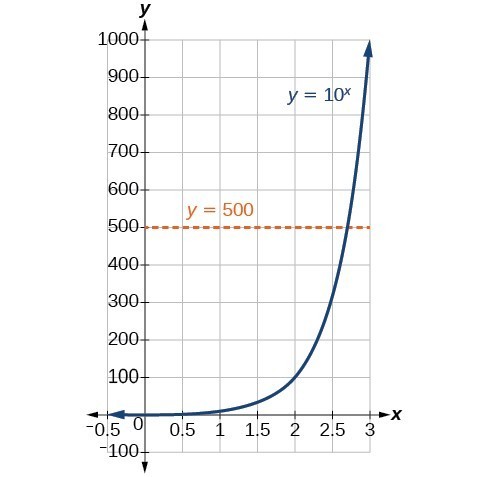How To Change Log To Exponential Form
Learning Outcomes
- Convert from logarithmic to exponential class.
- Convert from exponential to logarithmic class.
In club to clarify the magnitude of earthquakes or compare the magnitudes of two different earthquakes, nosotros need to be able to convert between logarithmic and exponential form. For example, suppose the amount of energy released from i earthquake was 500 times greater than the amount of free energy released from some other. We want to calculate the difference in magnitude. The equation that represents this problem is [latex]{10}^{x}=500[/latex] where x represents the divergence in magnitudes on the Richter Calibration. How would nosotros solve forten?
We take not yet learned a method for solving exponential equations algebraically. None of the algebraic tools discussed and so far is sufficient to solve [latex]{10}^{10}=500[/latex]. We know that [latex]{10}^{two}=100[/latex] and [latex]{10}^{3}=g[/latex], and then it is articulate that ten must exist some value between 2 and 3 since [latex]y={x}^{x}[/latex] is increasing. We can examine a graph to better estimate the solution.

Estimating from a graph, however, is imprecise. To observe an algebraic solution, we must introduce a new function. Observe that the graph to a higher place passes the horizontal line test. The exponential function [latex]y={b}^{ten}[/latex] is one-to-ane, so its changed, [latex]x={b}^{y}[/latex] is likewise a role. As is the case with all inverse functions, we just interchange x and y and solve for y to discover the inverse function. To represent y equally a function of x, we use a logarithmic part of the grade [latex]y={\mathrm{log}}_{b}\left(x\right)[/latex]. The base blogarithm of a number is the exponent by which we must raise b to get that number.
Nosotros read a logarithmic expression as, "The logarithm with base of operations b of x is equal to y," or, simplified, "log base b of x is y." Nosotros tin can also say, "b raised to the ability of y is x," because logs are exponents. For example, the base of operations ii logarithm of 32 is 5, because 5 is the exponent nosotros must apply to 2 to become 32. Since [latex]{2}^{5}=32[/latex], we tin write [latex]{\mathrm{log}}_{ii}32=5[/latex]. We read this as "log base 2 of 32 is v."
We can limited the relationship between logarithmic grade and its corresponding exponential form as follows:
[latex]{\mathrm{log}}_{b}\left(10\right)=y\Leftrightarrow {b}^{y}=x,\text{}b>0,b\ne ane[/latex]
Note that the base b is always positive.

Because a logarithm is a function, it is nearly correctly written as [latex]{\mathrm{log}}_{b}\left(x\correct)[/latex] using parentheses to denote function evaluation simply as we would with [latex]f\left(x\correct)[/latex]. However, when the input is a unmarried variable or number, it is mutual to run into the parentheses dropped and the expression written without parentheses every bit [latex]{\mathrm{log}}_{b}ten[/latex]. Note that many calculators require parentheses around the x.
We tin illustrate the notation of logarithms as follows:

Observe that when comparison the logarithm function and the exponential function, the input and the output are switched. This ways [latex]y={\mathrm{log}}_{b}\left(x\correct)[/latex] and [latex]y={b}^{10}[/latex] are inverse functions.
A Full general Note: Definition of the Logarithmic Function
A logarithm base b of a positive number x satisfies the following definition:
For [latex]x>0,b>0,b\ne one[/latex],
[latex]y={\mathrm{log}}_{b}\left(x\right)\text{ is equal to }{b}^{y}=ten[/latex], where
- we read [latex]{\mathrm{log}}_{b}\left(10\right)[/latex] as, "the logarithm with base b of x" or the "log base b of x."
- the logarithm y is the exponent to which b must exist raised to get 10.
- if no base [latex]b[/latex] is indicated, the base of the logarithm is assumed to exist [latex]ten[/latex].
Besides, since the logarithmic and exponential functions switch the x and y values, the domain and range of the exponential function are interchanged for the logarithmic function. Therefore,
- the domain of the logarithm function with base [latex]b \text{ is} \left(0,\infty \right)[/latex].
- the range of the logarithm function with base of operations [latex]b \text{ is} \left(-\infty ,\infty \right)[/latex].
Q & A
Can we take the logarithm of a negative number?
No. Because the base of an exponential role is e'er positive, no ability of that base tin ever exist negative. Nosotros can never have the logarithm of a negative number. Also, nosotros cannot take the logarithm of zero. Calculators may output a log of a negative number when in circuitous mode, merely the log of a negative number is not a real number.
How To: Given an equation in logarithmic grade [latex]{\mathrm{log}}_{b}\left(10\right)=y[/latex], convert information technology to exponential class
- Examine the equation [latex]y={\mathrm{log}}_{b}ten[/latex] and identify b, y, and ten.
- Rewrite [latex]{\mathrm{log}}_{b}x=y[/latex] as [latex]{b}^{y}=x[/latex].
Instance: Converting from Logarithmic Form to Exponential Form
Write the following logarithmic equations in exponential grade.
- [latex]{\mathrm{log}}_{6}\left(\sqrt{6}\correct)=\frac{1}{2}[/latex]
- [latex]{\mathrm{log}}_{3}\left(nine\correct)=2[/latex]
Try It
Write the following logarithmic equations in exponential class.
- [latex]{\mathrm{log}}_{10}\left(1,000,000\right)=6[/latex]
- [latex]{\mathrm{log}}_{5}\left(25\right)=two[/latex]
Convert from Exponential to Logarithmic Class
To catechumen from exponential to logarithmic grade, we follow the same steps in reverse. We identify the base of operations b, exponent 10, and output y. Then we write [latex]x={\mathrm{log}}_{b}\left(y\correct)[/latex].
Example: Converting from Exponential Form to Logarithmic Form
Write the post-obit exponential equations in logarithmic form.
- [latex]{2}^{3}=viii[/latex]
- [latex]{5}^{2}=25[/latex]
- [latex]{ten}^{-4}=\frac{1}{10,000}[/latex]
Try It
Write the following exponential equations in logarithmic form.
- [latex]{3}^{2}=9[/latex]
- [latex]{5}^{iii}=125[/latex]
- [latex]{2}^{-1}=\frac{1}{2}[/latex]
Contribute!
Did you lot take an idea for improving this content? Nosotros'd beloved your input.
Improve this pageLearn More
Source: https://courses.lumenlearning.com/waymakercollegealgebra/chapter/convert-between-logarithmic-and-exponential-form/
Posted by: angcounts.blogspot.com

0 Response to "How To Change Log To Exponential Form"
Post a Comment